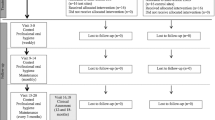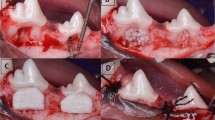Abstract
The aim of the present study was to evaluate histologically in dogs the effect of treating intrabony defects with an oily calcium hydroxide suspension (OCHS). Intrabony defects were surgically created bilaterally at the distal aspects of the maxillary first premolars and at the mesial aspects of the third premolars in two mongrel dogs. Subsequently, the defects were randomly treated with (a) access flap surgery followed by the application of an OCHS or (b) access flap surgery alone. After 8 weeks of healing, the animals were killed. Dissected blocks containing the experimental specimens were fixed in formalin, decalcified in EDTA, and embedded in paraffin. The formation of new cementum and bone was assessed histomorphometrically. In the control group, healing was predominantly characterized by the formation of a long junctional epithelium along the root surface and limited periodontal regeneration at the most apical part of the defect. The OCHS-treated defects consistently revealed periodontal regeneration (i.e., new periodontal ligament, new cementum with inserting collagen fibers, and new bone). Within the limits of the present study, it can be concluded that OCHS may favor periodontal regeneration in acute-type intrabony periodontal defects.




Similar content being viewed by others
References
Brunsvold MA, Mellonig JT (1993) Bone grafts and periodontal regeneration. Periodontol 2000 1:80–91
Caton JG, Greenstein G (1993) Factors related to periodontal regeneration. Periodontol 2000 1:9–15
Caton J, Nyman S (1980) Histometric evaluation of periodontal surgery. I. The modified Widman flap procedure. J Clin Periodontol 7:212–223
Caton J, Nyman S, Zander H (1980) Histometric evaluation of periodontal surgery. II. Connective tissue attachment levels after four regenerative procedures. J Clin Periodontol 7:224–231
Caton J, Mota L, Gandini L, Laskaris B (1994) Non-human primate models for testing the efficacy and safety of periodontal regeneration procedures. J Periodontol 65:1143–1150
Charles P, Nathalie S, Carine D, Alexandru G (2004) Calcium hydroxide and treatment of inflammatory inter-radicular bone resorption of non-vital deciduous molars. Rev Belge Med Dent 59:163–169
Claffey N, Polyzois I, Ziaka P (2004) An overview of nonsurgical and surgical therapy. Periodontol 2000 36:35–44
Cochran DL, King GN, Schoolfield J, Velasquez-Plata D, Mellonig JT, Jones A (2003) The effect of enamel matrix proteins on periodontal regeneration as determined by histological analyses. J Periodontol 74:1043–1055
De Moor RJ, De Witte AM (2002) Periapical lesions accidentally filled with calcium hydroxide. Int Endod J 35:946–958
De Rossi A, Silva LA, Leonardo MR, Rocha LB, Rossi MA (2005) Effect of rotary or manual instrumentation, with or without a calcium hydroxide/1% chlorhexidine intracanal dressing, on the healing of experimentally induced chronic periapical lesions. Oral Surg Oral Med Oral Pathol Oral Radiol Endod 99:628–636
Evanov C, Liewehr F, Buxton TB, Joyce AP (2004) Antibacterial efficacy of calcium hydroxide and chlorhexidine gluconate irrigants at 37 degrees C and 46 degrees C. J Endod 30:653–657
Gottlow J, Nyman S, Karring T, Lindhe J (1984) New attachment formation as the result of controlled tissue regeneration. J Clin Periodontol 11:494–503
Haenni S, Schmidlin PR, Mueller B, Sener B, Zehnder M (2003) Chemical and antimicrobial properties of calcium hydroxide mixed with irrigating solutions. Int Endod J 36:100–105
Holland R, de Mello W, Nery MJ, Bernabe PF, de Souza V (1977) Reaction of human periapical tissue to pulp extirpation and immediate root canal filling with calcium hydroxide. J Endod 3:63–67
Isidor F, Karring T, Nyman S, Lindhe J (1985) New attachment–reattachment following reconstructive periodontal surgery. J Clin Periodontol 12:728–735
Karring T, Nyman S, Gottlow J, Laurell L (1993) Development of the biological concept of guided tissue regeneration–animal and human studies. Periodontol 2000 1:26–35
Karring T, Lindhe J, Cortellini P (1997) Regenerative periodontal therapy. Clinical periodontology and implant dentistry, 3rd edn. Munksgaard, Copenhagen, pp 597–646
Klaiber B, Mittermayer C, Kaden P, Schwechten I (1981) Determination of the toxicity of root canal filling materials and their separate components in cell cultures. Dtsch Zahnarztl Z 36:212–216
Liang Y, Wang J, Yu S (2000) Mechanisms of bone repairment in periapical diseases: studies on adjusting bone metabolism with calcium hydroxide in vitro. Zhonghua Kou Qiang Yi Xue Za Zhi 35:112–114
Lowenguth RA, Blieden TM (1993) Periodontal regeneration: root surface demineralization. Periodontol 2000 1:54–68
Lynch SE, Williams RC, Polson AM, Howell TH, Reddy MS, Zappa UE, Antoniades HN (1989) A combination of platelet-derived and insulin-like growth factors enhances periodontal regeneration. J Clin Periodontol 16:545–548
Nyman S, Lindhe J, Karring T, Rylander H (1982) New attachment following surgical treatment of human periodontal disease. J Clin Periodontol 9:290–296
Sculean A, Donos N, Brecx M, Reich E, Karring T (2000) Treatment of intrabony defects with guided tissue regeneration and enamel-matrix-proteins. An experimental study in monkeys. J Clin Periodontol 27:466–472
Sculean A, Stavropoulos A, Berakdar M, Windisch P, Karring T, Brecx M (2005) Formation of human cementum following different modalities of regenerative therapy. Clin Oral Investig 9:58–64
Tepel J, Darwisch el Sawaf M, Hoppe W (1994) Reaction of inflamed periapical tissue to intracanal medicaments and root canal sealers. Endod Dent Traumatol 10:233–238
Tronstad L (1988) Root resorption-etiology, terminology and clinical manifestations. Endod Dent Traumatol 4:241–252
Wikesjö UM, Selvig KA, Zimmerman G, Nilveus R (1991) Periodontal repair in dogs: healing in experimentally created chronic periodontal defects. J Periodontol 62:258–263
Author information
Authors and Affiliations
Corresponding author
Rights and permissions
About this article
Cite this article
Schwarz, F., Stratul, SI., Herten, M. et al. Effect of an oily calcium hydroxide suspension (Osteoinductal) on healing of intrabony periodontal defects. A pilot study in dogs. Clin Oral Invest 10, 29–34 (2006). https://doi.org/10.1007/s00784-005-0019-y
Received:
Accepted:
Published:
Issue Date:
DOI: https://doi.org/10.1007/s00784-005-0019-y




